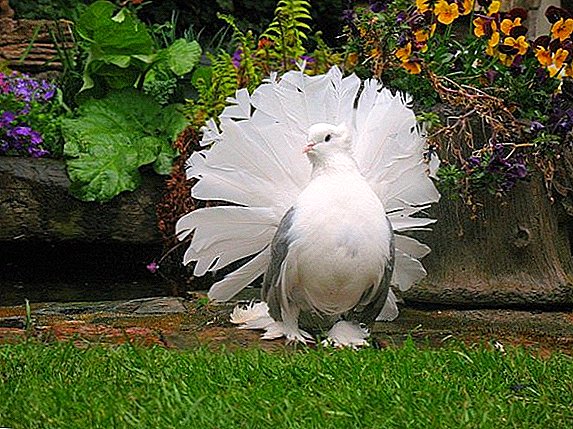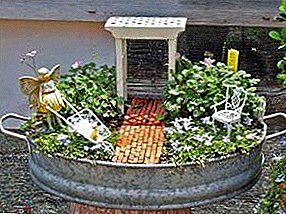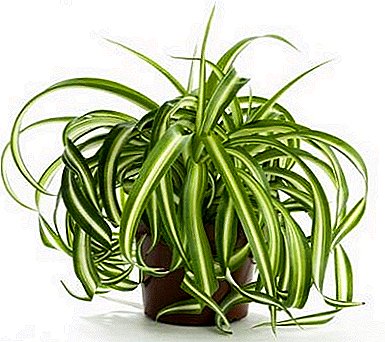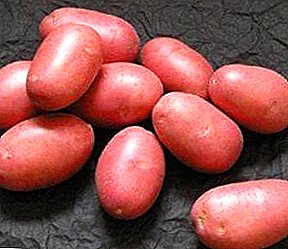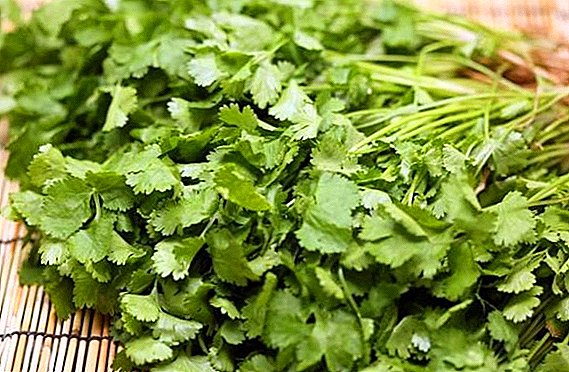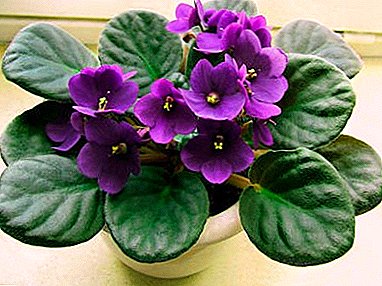
Violet is a very beautiful ornamental plant, which is loved by flower growers.
The flower is represented by thousands of varieties registered and still in breeding, many well-known, but not included in the registry.
Often these are hybrids, resulting in random selection. What conditions are necessary for the plant to please its flowering, we will tell later in the article.
Pot selection
Indoor violets are small plants with a very small root system.. Even varieties with abundant foliage do not take up much space in the pot. Therefore, a flower container is needed small. For young plants suitable pot size of 6-7 centimeters, and for violets older enough to take a capacity of 10-12 centimeters.
Soil composition
 It will require an acidic composition, which includes peat, dried sphagnum moss, charcoal, sand and leaf earth. At the same time, coal and moss should make up no more than 10% of the total composition.
It will require an acidic composition, which includes peat, dried sphagnum moss, charcoal, sand and leaf earth. At the same time, coal and moss should make up no more than 10% of the total composition.
- Peat - 3 parts.
- Sheet earth - 3 parts.
- River sand - 1 part.
A solution of humate is added to the impoverished soil composition once a year., do it in the winter. In spring and autumn, mineral supplements are carried out. The main condition is to avoid overfeeding the land, it should always be skinny.
Humidity
Violet is a plant that loves moisture. In the wild, it grows near water bodies, so dry air has a negative effect on the flower. In winter, it is better to remove the plant away from the heating devices. For moisturizing, experienced growers advise you to spray violet leaves in small streams.
Important! Water in no case should not fall on the buds, flowers or sockets. It is best to moisten the flower with the help of a pallet with a wet claydite. You can also place a container with water near the pot.
Lighting
The flower requires a lit place, but without direct sunlight. For species whose foliage has a dark green color and dense texture, more lighting is required. The east or west side will be a great location for a pot with a plant.
If the plant has to be put on the windowsill, whose windows face the south side, it is necessary to arrange a shade. You can do this by gluing windows with strips of parchment. To protect the plant from the midday sultry rays, it is worth curtain curtains window.
Light day for violets should be at least 14 hours, if it is smaller, then it can be increased using a fluorescent lamp.
Temperature conditions
The temperature in the summer should be about 23-24 degrees. Observing such a temperature regime, violets will have a lush flowering and a healthy appearance. In autumn and winter, the temperature should not fall below +16 degrees. You need to be especially vigilant during the heating season and to prevent hot air from entering the violet.
How to water?
 What you need to know about watering - the ground in which the flower grows should never dry and turn into solidified clod of earth. You need to water 2-3 times a week. The frequency of the procedure will depend on the season, soil and humidity of the room.
What you need to know about watering - the ground in which the flower grows should never dry and turn into solidified clod of earth. You need to water 2-3 times a week. The frequency of the procedure will depend on the season, soil and humidity of the room.
It is necessary to ensure that there is no swamp in the pot. Ideal water for irrigation - defended and soft. Watering should be carried out carefully. The liquid should not fall on the plant itself.
Watering rules:
- It is necessary to determine the type of irrigation - normal, pan, wick. Wicky way - more comfortable than others. If you configure the system, the violet can not be watered for several weeks.
- Water is removed from the pallet after 20 minutes.
- The liquid is needed separated, boiled or filtered.
- The water temperature is about 20 degrees.
Next, a visual video about watering violets:
What is wick watering?
In recent years, this method has gained unprecedented popularity among gardeners. It greatly simplifies the care of violet and here's why:
- It takes little time.
- For a long period, the plant can be left unattended.
- Much simplifies watering in the summer.
Fertilizers
During the year, violet feed several times. Minerals are fertilized twice in spring and autumn. In winter, organic is applied once. If the flower is in excellent condition, in the summer there is no need to fertilize. Fertilizers fit complex for violets, they are sold in every flower shop.
 Top dressing is done only in wet soil. To avoid burns, it is necessary to dilute the preparations in large quantities of water, even more than indicated on the package. The main components of fertilizers are nitrogen, phosphorus and potassium. Nitrogen fertilizers are recommended to use during active growth of violets. And phosphate and potash fertilizers are applied at the time of bud formation and during flowering.
Top dressing is done only in wet soil. To avoid burns, it is necessary to dilute the preparations in large quantities of water, even more than indicated on the package. The main components of fertilizers are nitrogen, phosphorus and potassium. Nitrogen fertilizers are recommended to use during active growth of violets. And phosphate and potash fertilizers are applied at the time of bud formation and during flowering.
When choosing fertilizers should be very careful. For violets, only fertilizers suitable for flowering houseplants are suitable.. Often, growers choose the wrong supplements, and this leads to the death of the flower (what to do if the violet does not bloom?)
Next, a visual video about fertilizer violets:
Differences Uzambarskogo view from indoor
Differences from ordinary violets:
- Leaf color. The top of the sheet is green in various shades. Sometimes it can be olive green or even black. The underside of the leaf is white, pinkish, greenish or dark purple.
- Differs in the type of flower. The flowers can be standard star-shaped, bell-shaped or rare types (the top row of petals is rolled upwards, and the bottom ones are very wide).
- The flowers of the plant can have many shades. The color consists of several tones, which gives the violet a fantastic appearance.
- Uzambar violet habitat - Africa.
This species is very negative about low temperatures and drafts.. Soil for this flower is better to buy in the store. Uzambara violet prefers generous dressing and does not tolerate improper watering. It should not be frequent or excessive.
This plant does not tolerate dust, therefore, as soon as they noticed it, you immediately need to spray the leaves, thereby washing away the dust from the violet.
You can read about the diversity of violet species in a separate article.
Cultivation, reproduction and transplanting at home
Reproduction can be carried out:
- Leaves.
- Cuttings.
- Seeds.
- Rooting peduncle.
 The easiest and easiest way to reproduce is leaf rooting.:
The easiest and easiest way to reproduce is leaf rooting.:
- Before rooting, the cut sheet must be updated and disinfected.
- Then lower it into the water and keep there until the roots appear.
- When they reach 5-7 centimeters, the leaf takes root.
In the process of transplanting:
- It is imperative to pay attention to the state of the root system. All dead and brown roots are removed. You need to leave only bright and lively.
- The plant is recommended to be washed in water.
- The roots are laid out and planted in a prepared container.
If the rot completely ate the root system, it means that the flower must be cleaned to a living tissue, then sprinkled with activated charcoal, dried and rooted again.
You will learn about all the rules of transplantation and the subsequent care of the plant in this article, and how easy it is to grow this beautiful plant, read here.
Next, a visual video about transplanting violets:
Also a video about the reproduction of violet leaf:
Diseases of the home plant
- Mealy dew. It appears on the violet in the wrong light, temperature below +16 degrees, dusty room. It looks like a white bloom on the stems. To get rid of the disease. Carefully wipe the leaves with a damp cloth and ventilate the room. If this does not help, use the drug - "Benlat".
- Gray rot. It may be formed as a result of temperature changes, abundant irrigation with cold water. Externally, it looks like a "fluffy" gray patina. For the destruction of gray rot fit - "Fitosparin", "Agat".
- Fusarium. Fungus, leading to decay of the roots. Occurs due to improper watering. With this disease, the violet does not bloom, and the leaves turn gray and crumble. It will help to heal the solution of fundozol.
How to help your plant, if it is sick or prone to attack, we are told here.
Useful video about the disease of violets:
Conclusion
Indoor violet is a wonderful plant, pleasing with its unique beauty and variety of shades of flowers. But do not forget that even such a common plant among gardeners requires to itself proper and proper care.


